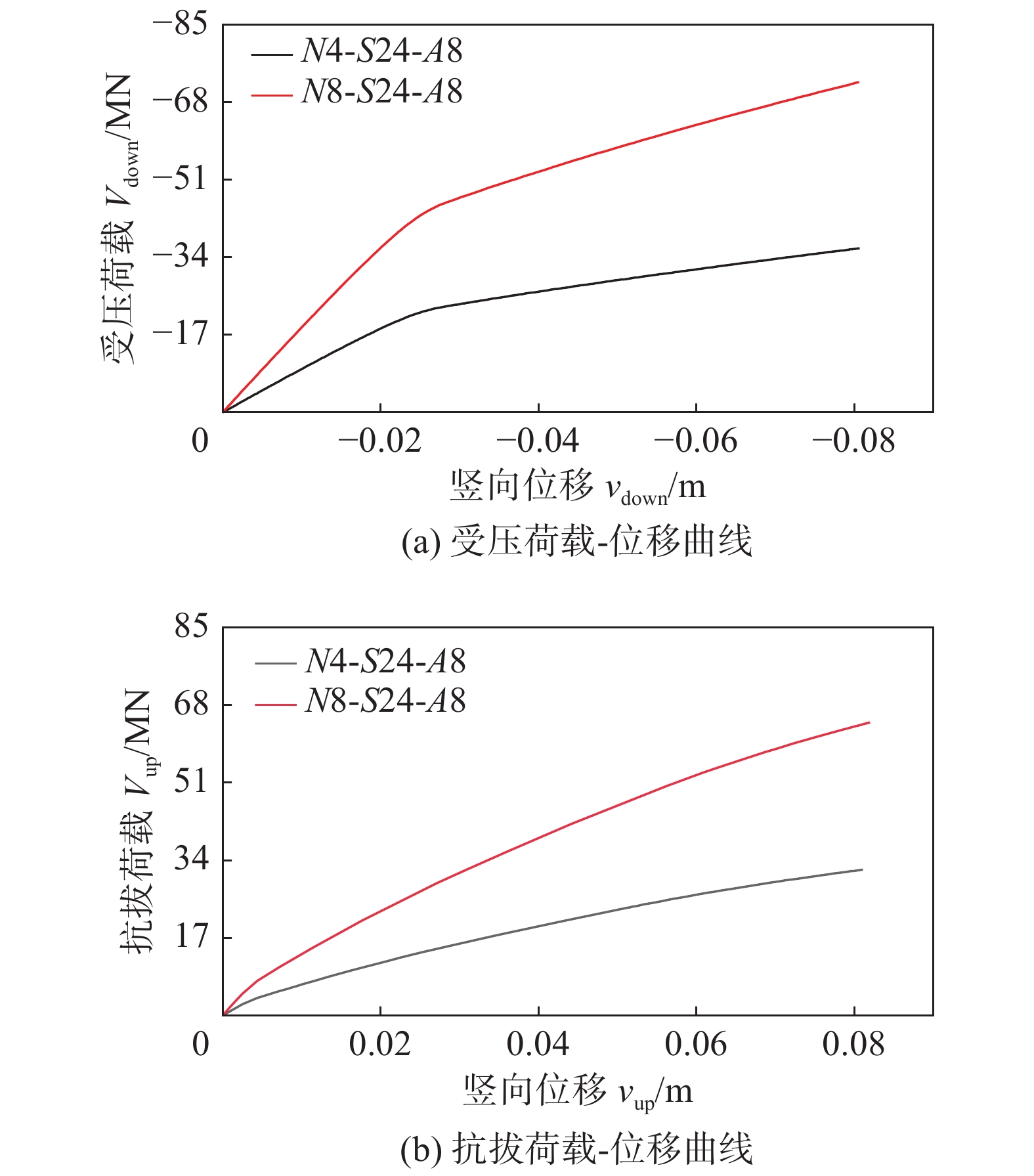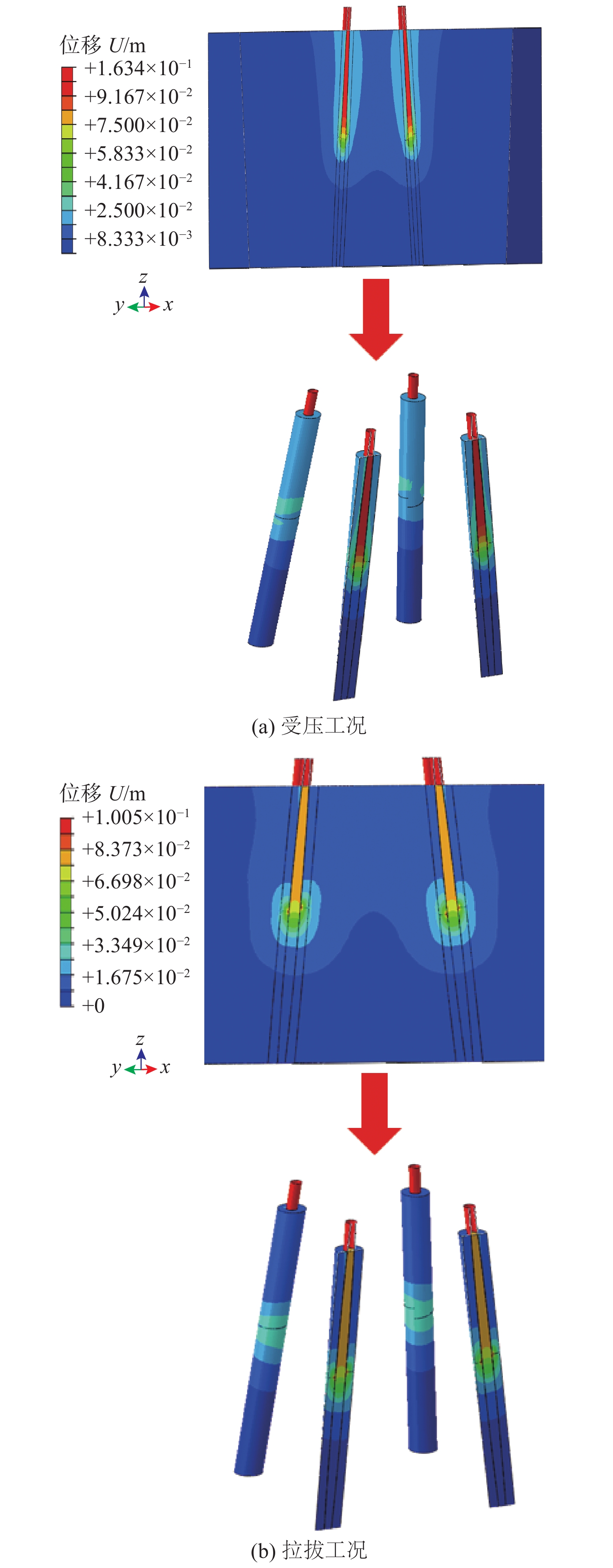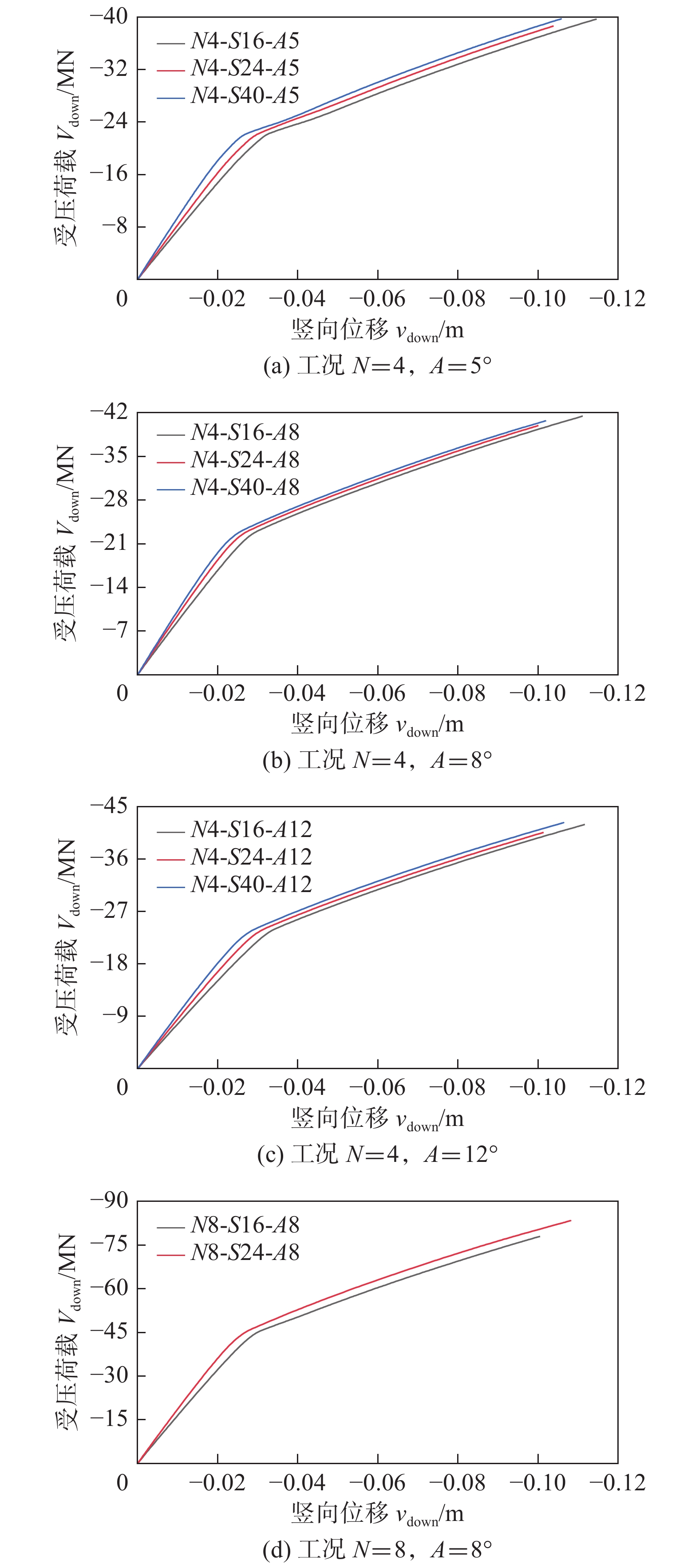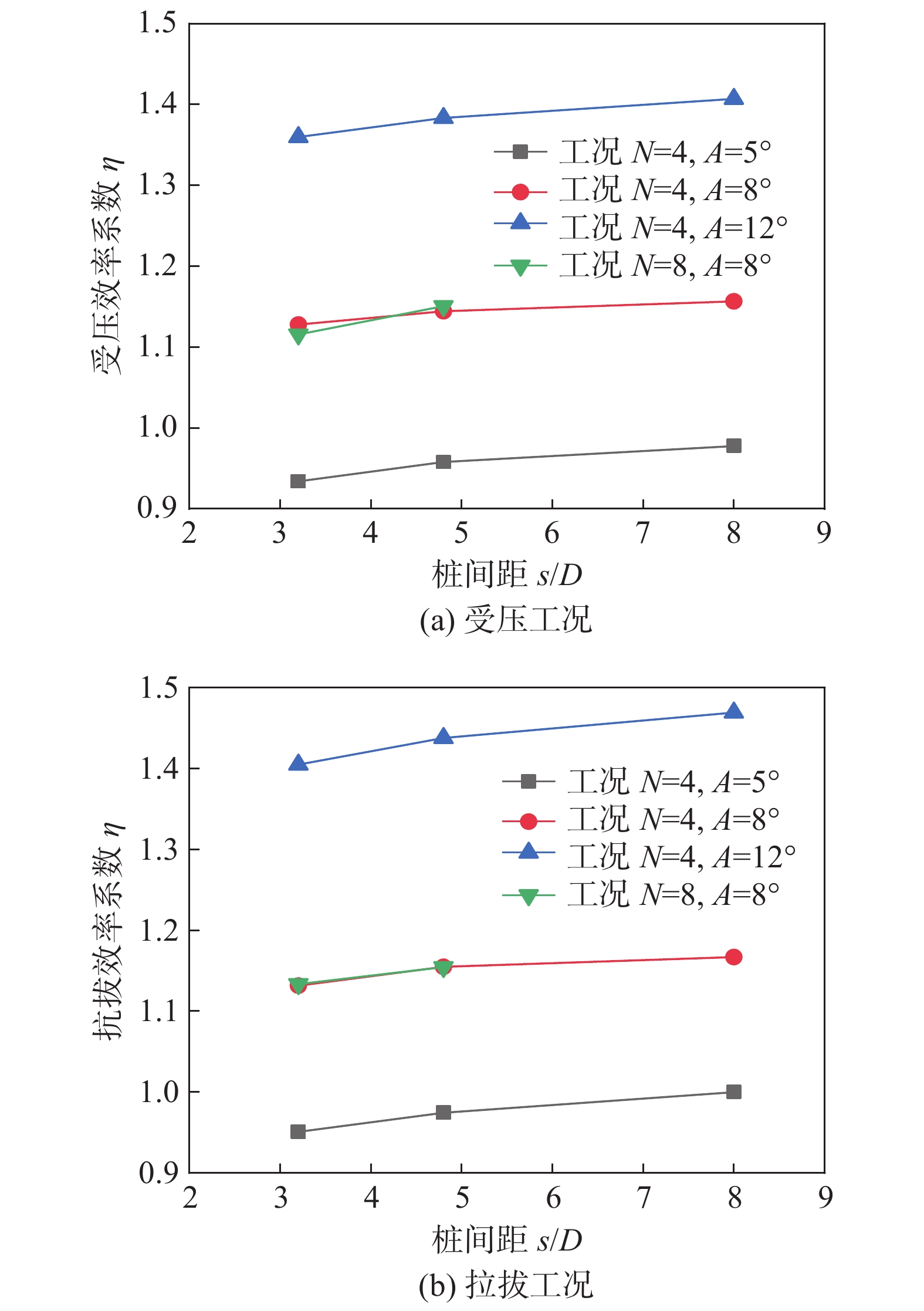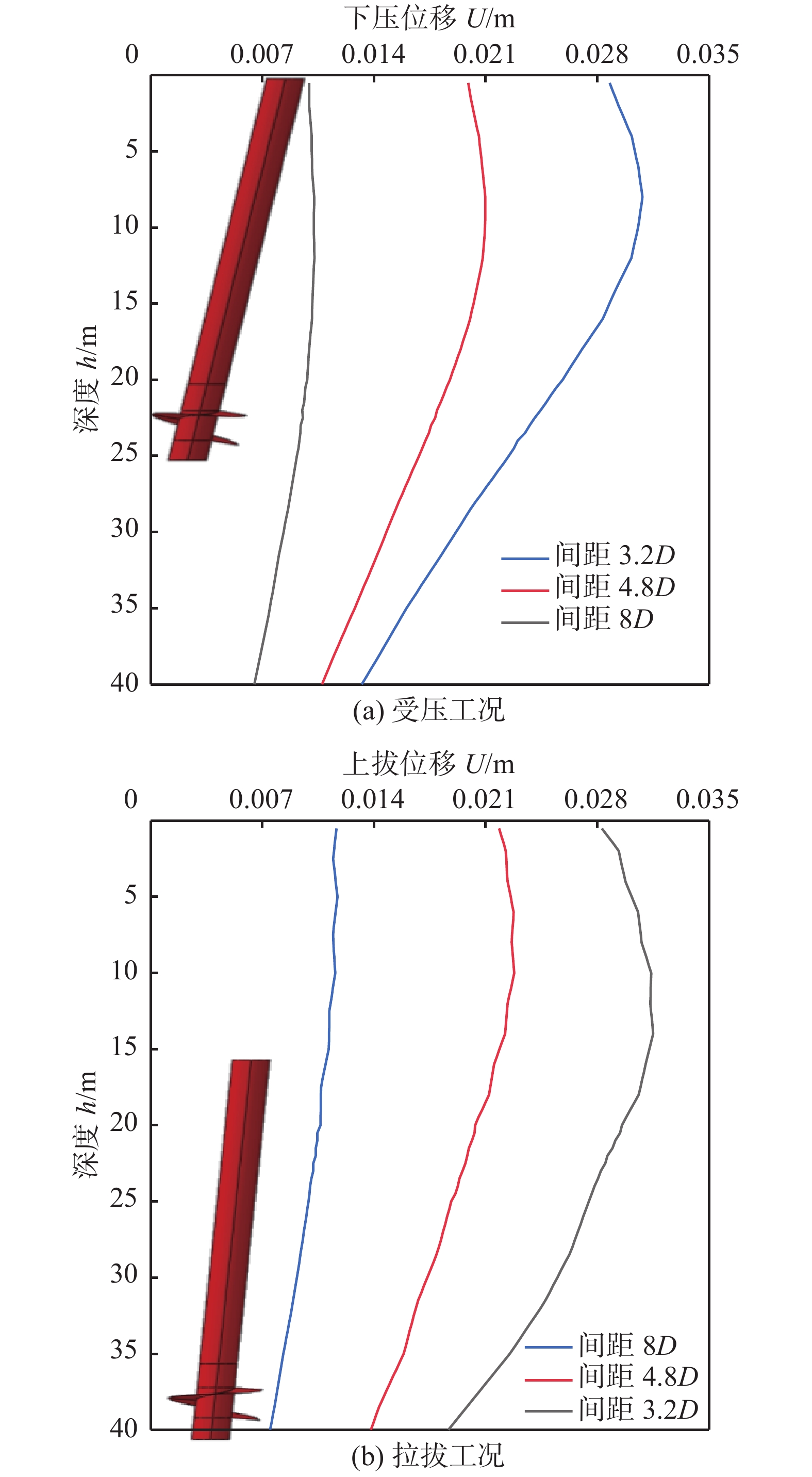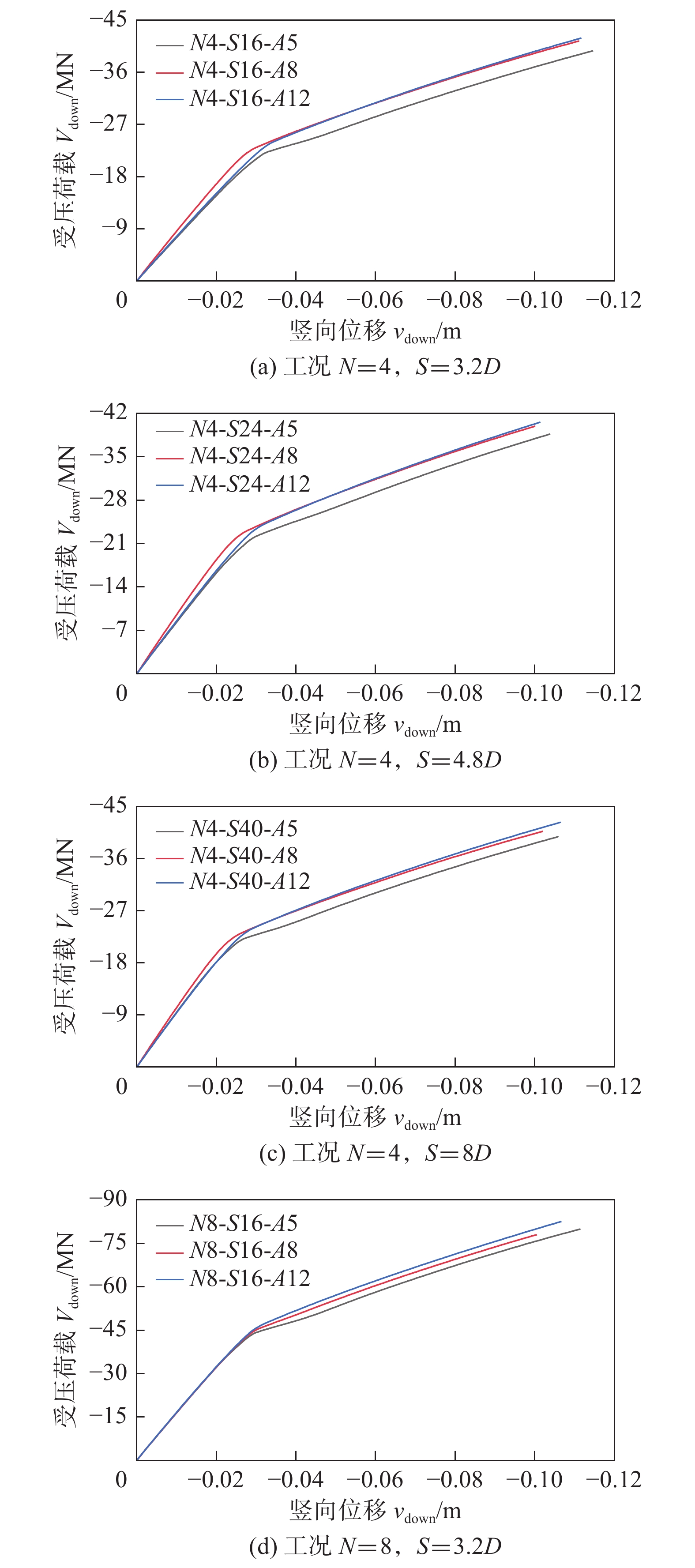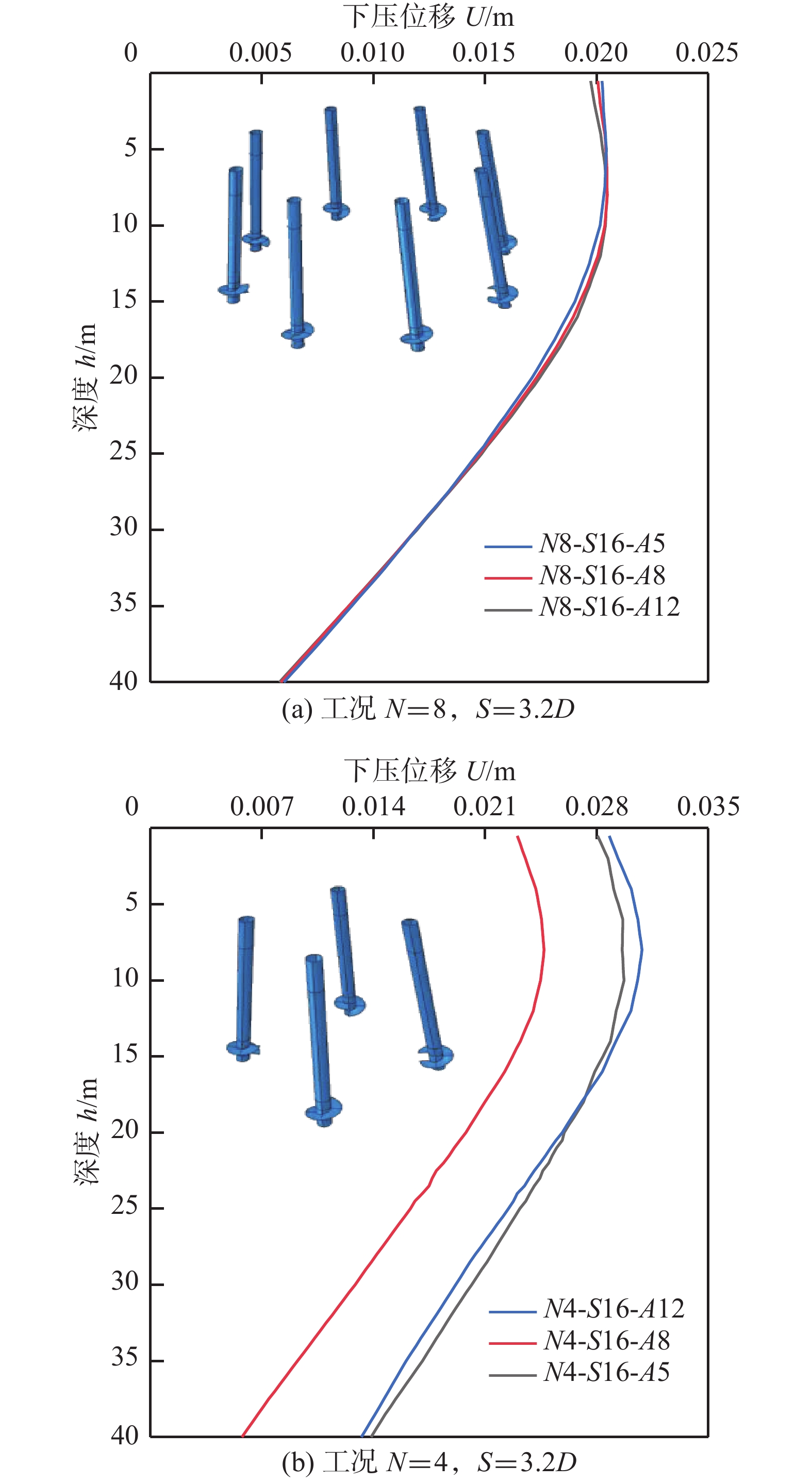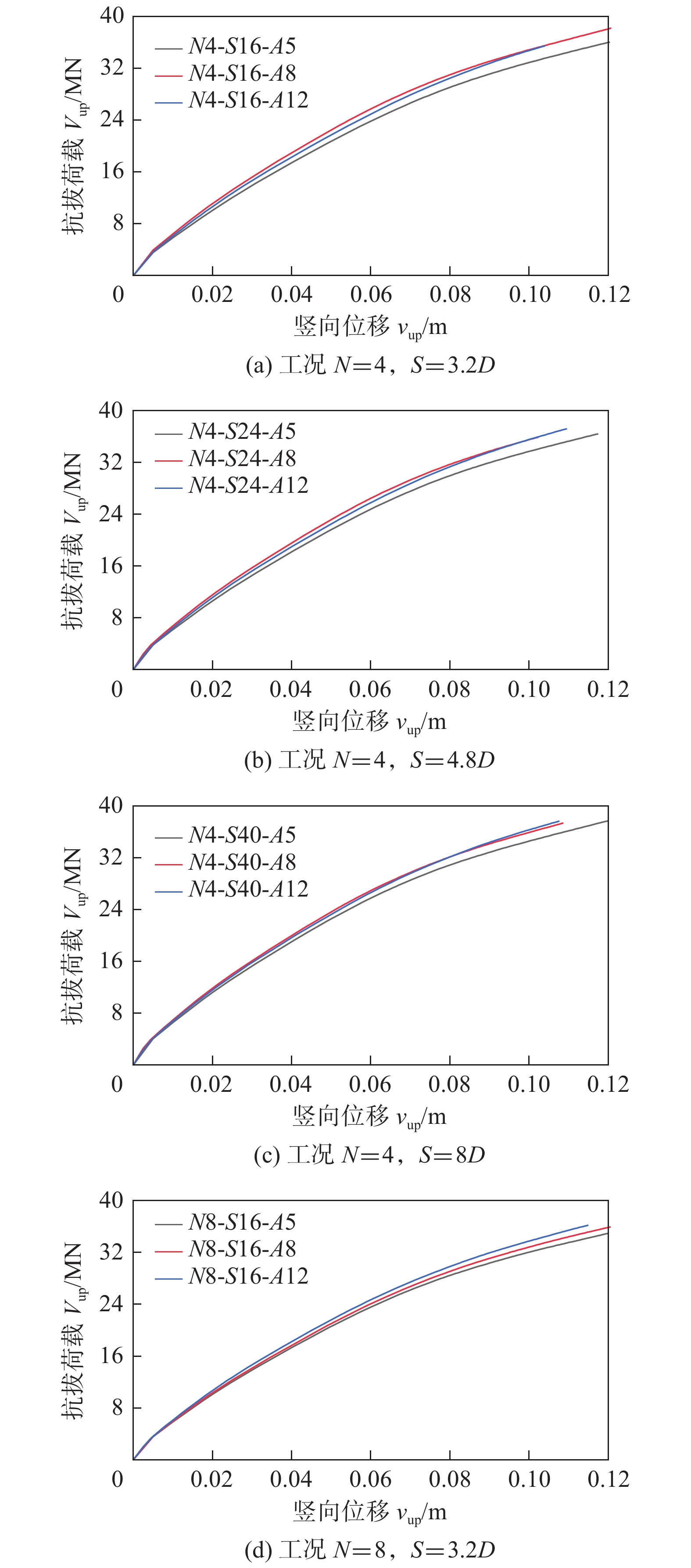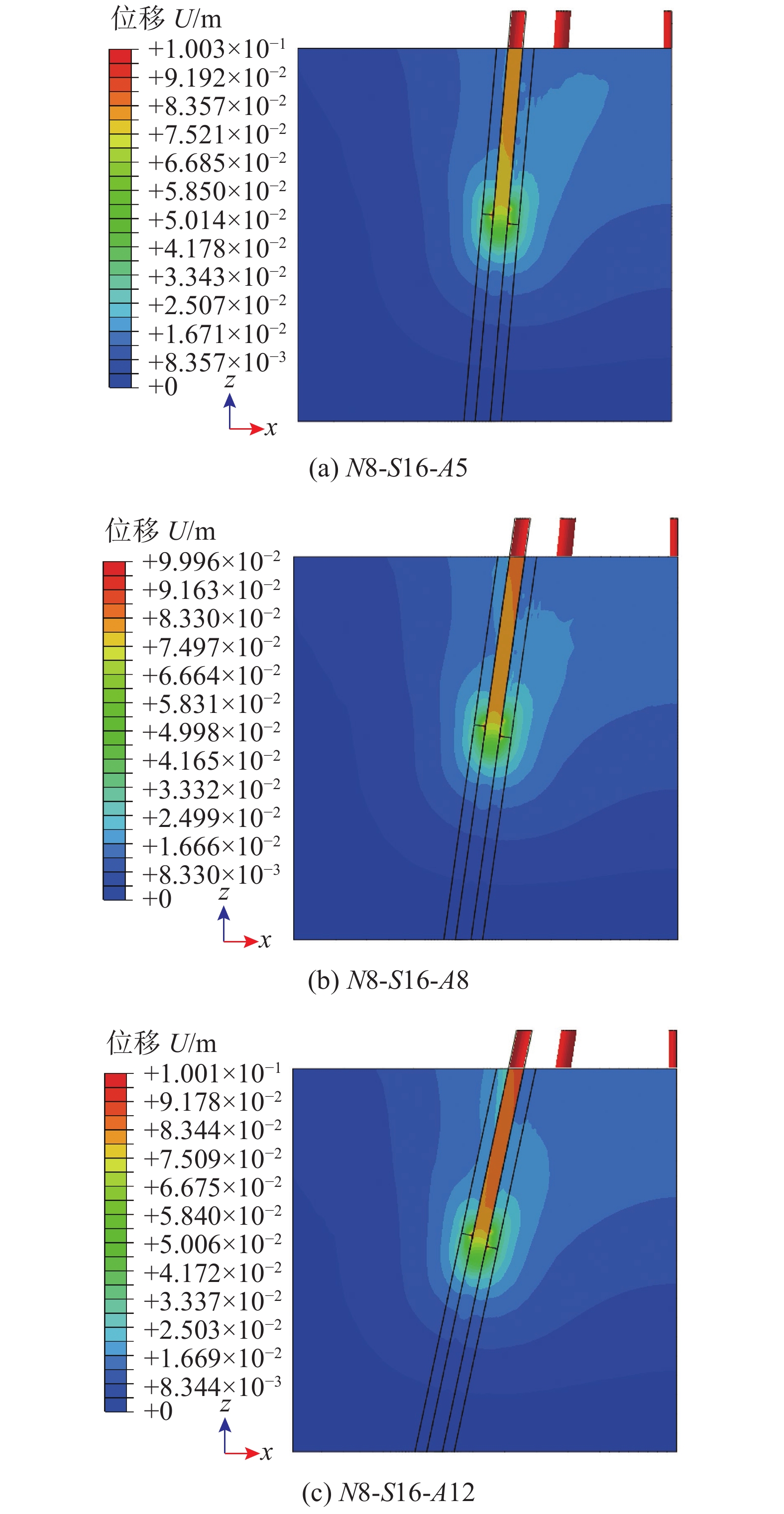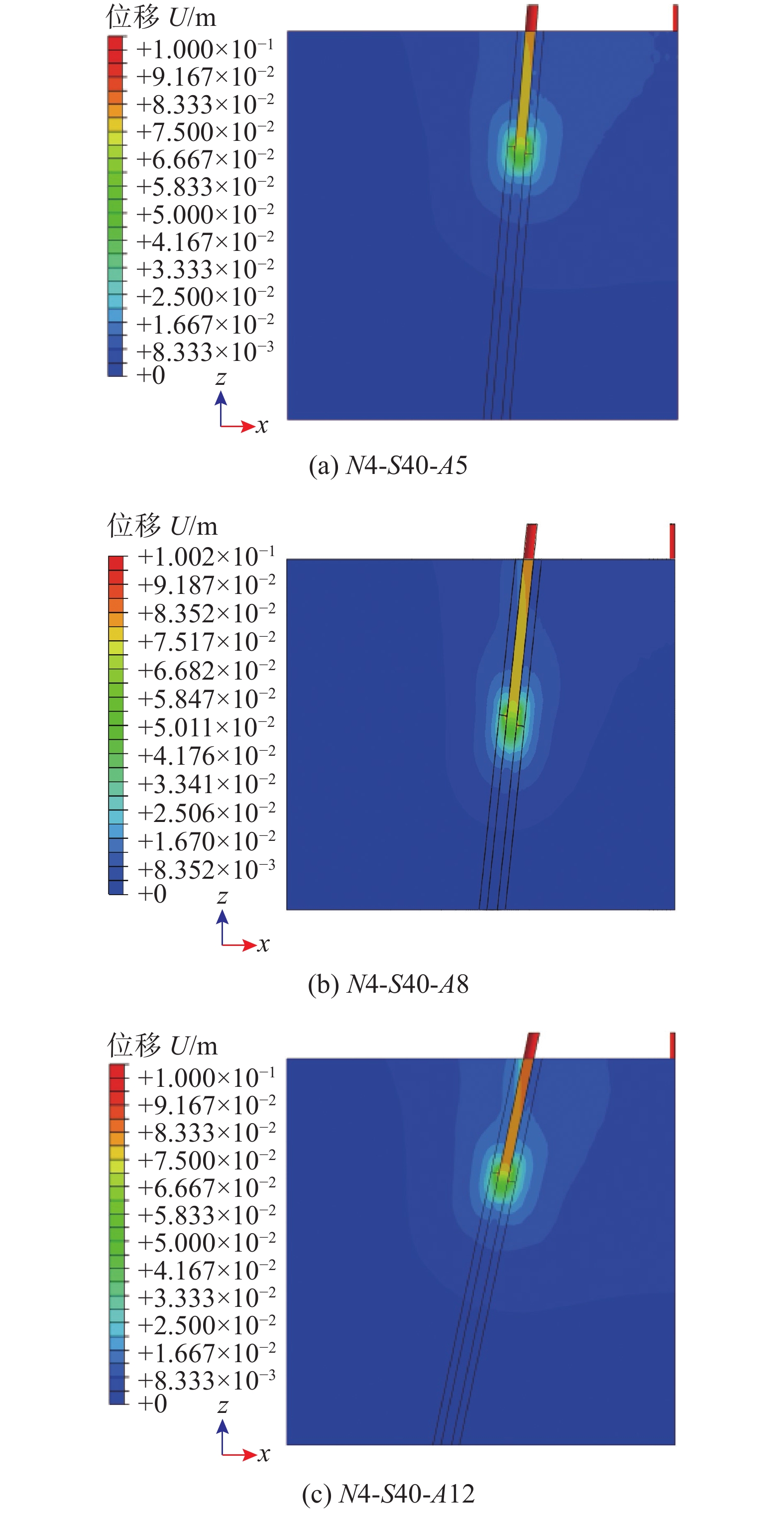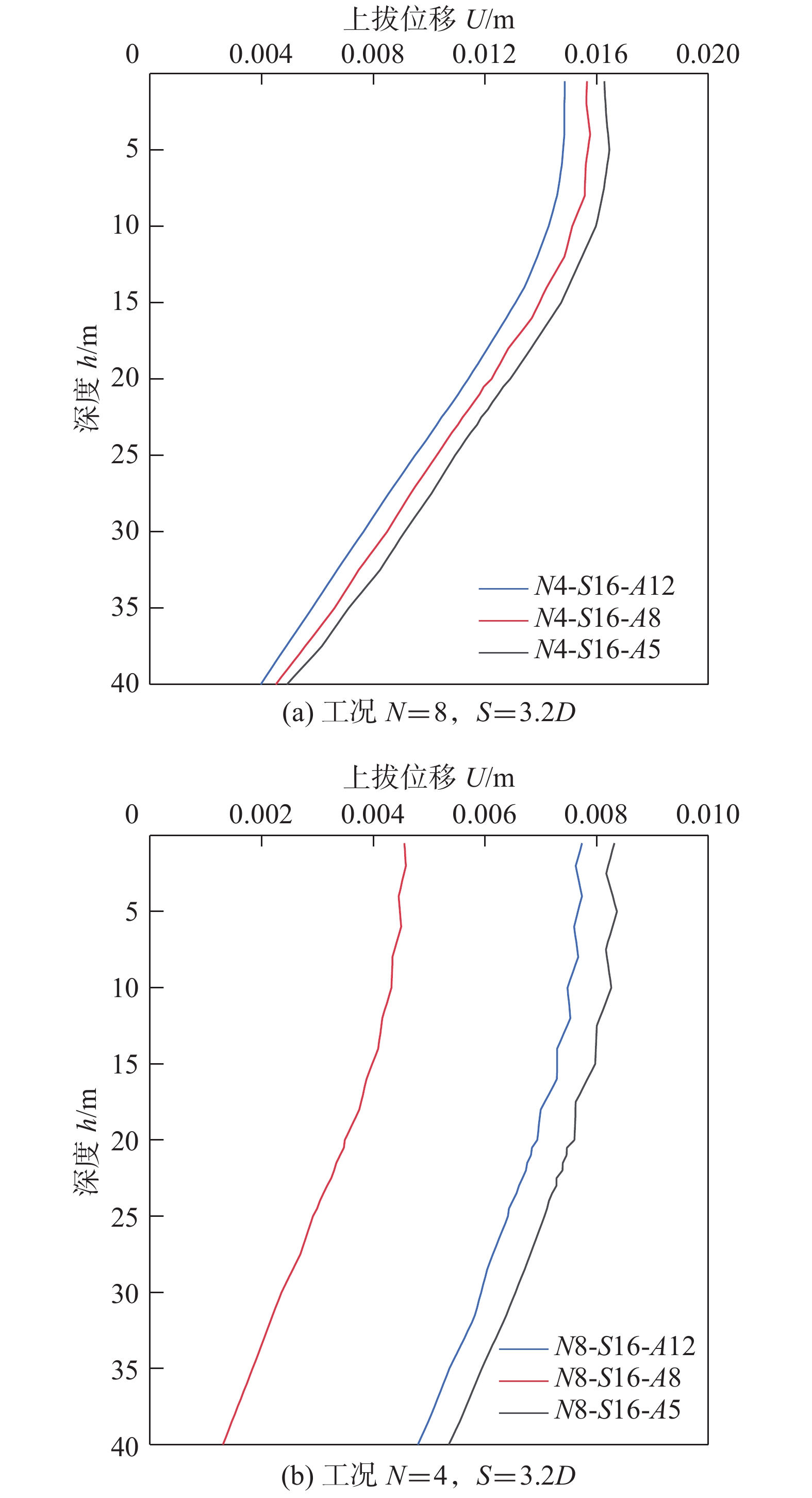-
在“双碳”目标的指引下,大力发展新能源,加快规划建设新型能源体系,实现新能源跃升式发展,已经成为我国能源发展之路的主旋律[1-3]。我国海岸线悠长,具备丰富的海上风能资源条件[4-5],大力开发海上风电,从而推进能源生产和消费革命,构建清洁低碳、安全高效的能源体系是实现我国“双碳”战略目标的必由之路[6-8]。
倾斜螺旋群桩基础作为一种海上风电基础“新技术”,其螺旋锚效应能提供较大的抗拔力[9-11],倾斜形式更加适应海上风电结构复杂的受荷特性[12-13],不仅有着传统高桩承台群桩基础承载性能优异、施工简便等优点,还兼有便于回收、成本低、环保安全等优势[14-16]。因此在我国海上风电大力发展的过程中,着重发展倾斜螺旋群桩基础势在必行[17-18]。
针对螺旋桩基础在海上风电中的应用,已有国内外学者进行了相关调查研究,并取得了一定的研究成果。早期HPTC的调查[19]显示螺旋桩具备丰富的发展潜力及广阔的应用前景;Byrne等[20]2015年对螺旋桩基础在海上风电工程中的可能性进行了研究,结果显示可行性较高;Amir Mansour Askari Fateh等[21]根据多个现场螺旋桩的CPT/CPTu数据建立数据库,从而预测了螺旋桩的轴向承载力;Ding[22-24]等通过开展试验研究了砂土中单叶片螺旋桩基础循环安装扭矩及承载力,并考虑了尺寸和竖向力对基础承载力的影响;周航[25]等通过室内模型试验,对黏土中安装效应下螺旋桩的抗拔承载力进行了研究;胡伟[26]等通过模型水平拉拔试验,分析了水平拉拔过程中螺旋桩锚片表面的土压力分布变化规律;韦芳芳[27]等通过数值模拟与已有承载试验的对比验证,分析了不同倾角下螺旋桩叶片数量和埋深对水平承载性能的影响规律;李青松[28]等基于圆孔扩张理论,修正了螺旋桩抗拔承载力计算方法,分析了螺旋桩抗拔极限承载力;刘志鹏[29]等通过对待定参数求导的方式,提出深埋工况下椭球面破坏模型;Deng[30-31]等通过开展现场试验,从桩间距、叶片直径等角度对黏土中螺旋桩群桩承载性能进行了研究。
综上可知,现阶段针对螺旋桩基础的研究成果主要集中于常规陆上竖直螺旋桩领域,而针对海上荷载作用下倾斜螺旋群桩基础的承载特性等研究尚未明确,且鉴于倾斜螺旋群桩基础在海上风电领域广袤的应用前景,有必要开展海上倾斜螺旋群桩承载特性的相关研究。
文章通过有限元软件对多种工况下倾斜螺旋群桩的承载力实验进行了模拟,探究了倾斜螺旋群桩承载力和群桩效应系数随桩数、倾斜角度和桩间距的变化规律。研究成果可为我国海上风电螺旋群桩基础建设提供研究思路及手段,有一定的科学意义和工程应用价值。
-
模拟选用ABAQUS有限元软件,选用饱和砂土海床作为地基模型及参数取值标准。对于复杂荷载作用下的倾斜螺旋群桩,需进行三维分析,且边界条件的设定应充分考虑螺旋桩土接触的变形程度,在本研究计算条件下,为消除边界效应并满足计算精度的要求,模型边界螺旋桩侧土体和桩端土体同时取40 m,即20倍桩径。算例中边界条件为:土体底部采用全约束ENCASTRE(U1=U2=U3=UR1=UR2=UR3=0),不允许各向位移和转动;土体侧边采用径向约束ZASYMM(U1=U2=UR3=0),仅允许竖直方向位移和扭转;土体上部为自由端。触面法向摩擦选择硬接触,切向采用罚函数,根据经验将砂土与螺旋桩之间的摩擦系数设置为0.3。
倾斜单桩模型如图1(a)所示;倾斜螺旋群桩基础模型如图1(b)所示;单元选择为土体均为C3D8R实体单元,螺旋桩采用S4R壳单元;不同工况建模的参数为:倾斜角度取5°、8°和12°,桩中心间距取16 m、24 m和40 m,桩数取4和8,后文中工况名称如N4-S16-A5,N表示桩数、S表示间距(m)、A表示倾斜角度(°),桩身参数如表1所示;土体为单层砂土,采用摩尔-库伦本构,非关联流动法则,土质如表2所示。
桩径d 叶片直径D 桩入土长度L 叶片数n/个 叶片距桩底t 螺距p 厚度 2 5 25 1 1.5 2 0.03 Table 1. Pile parameters
m 密度/(kg·m-3) 弹性模量/MPa 泊松比 内摩擦角/(°) 剪胀角/(°) 粘聚力/kPa 1200 18 0.3 34.4 0.1 5 Table 2. Soil parameters
-
文章中的有限元模型验证选取已有文献中的试验数据进行对比验证。王乐[18]通过开展螺旋桩大模型试验,研究了砂土相对密实度及叶片埋深、间距等因素对承载力及破坏模式的影响。
-
图2为不同桩数倾斜螺旋群桩荷载-位移曲线,由荷载-位移曲线可得群桩0.08 m位移时的极限承载力。
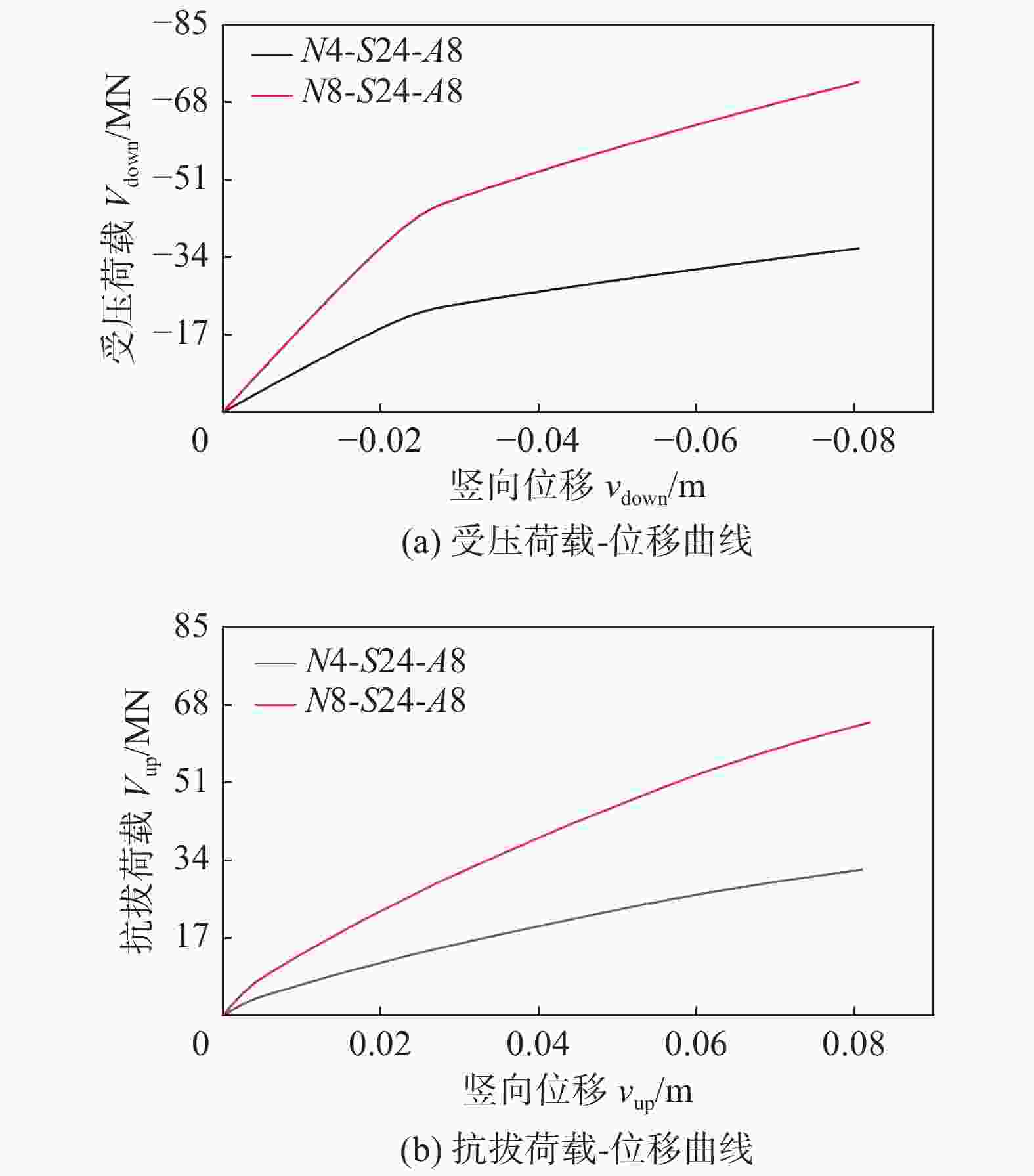
Figure 2. Bearing capacity of inclined helical pile-group foundations with different number of piles
表3为单根斜螺旋桩的承载力数据,根据群桩基础承载力和单桩承载力得到群桩效率系数(如表4所示),可发现螺旋倾斜群桩基础群桩效率系数大于1,即群桩中各基桩互相之间为正影响,承载力相较于单桩有较大提升;且桩数为8的群桩承载力为桩数为4的群桩承载力的2倍以上,即倾斜螺旋群桩效率系数随桩数增多而增大,且在群桩受压时该规律更明显。综合来看,倾斜螺旋群桩效率系数为正,相较于单桩基桩承载力提升了15%左右。
工况 抗拔承载力/MN 受压承载力/MN A5 8.6469 9.8916 A6.5 8.0068 9.0076 A8 7.6918 8.7180 A10 7.0008 8.0627 A12 6.1778 7.2854 Table 3. Bearing capacity of single inclined pile with vertical displacement of 0.08 m under various working conditions
工况 N4-S24-A8 N8-S24-A8 抗拔承载力Qu/MN 35.4826 71.0373 群桩效率抗拔系数ηu 1.1548 1.1560 受压承载力Qc/MN 39.8730 80.3218 群桩受压效率系数ηc 1.1434 1.1517 Table 4. Efficiency coefficient of inclined helical pile groups with different number of piles
图3为极限载荷情况下4桩倾斜螺旋群桩基础的受压和抗拔位移云图,8桩云图基本图形特征相似。如图3位移分布所示,两种工况以螺旋叶片为界,叶片上部桩身位移大于螺旋下部位移,即可知由于螺旋叶片的锚固作用,减小了桩底位移;群桩基础受压时位移分布等值线呈条形延伸至土面,拉拔时位移等值线在叶片深度附近呈现闭合,即说明拉拔时上部土体受到扰动较小,且受压时约0.016 m位移等值线邻桩相互连接形成整体,扩大了桩间土体的利用,群桩效应相较于拉拔作用下更为明显。
-
各工况下桩间距对于承载力的影响结果如图4所示,基础受压承载力随桩间距的增加而增大,最大与最小间距所对应的极限承载力差距在4%左右。抗拔承载力与抗压承载力呈现相同变化趋势,最大与最小间距所对应的极限抗拔承载力差距在3%~5%。
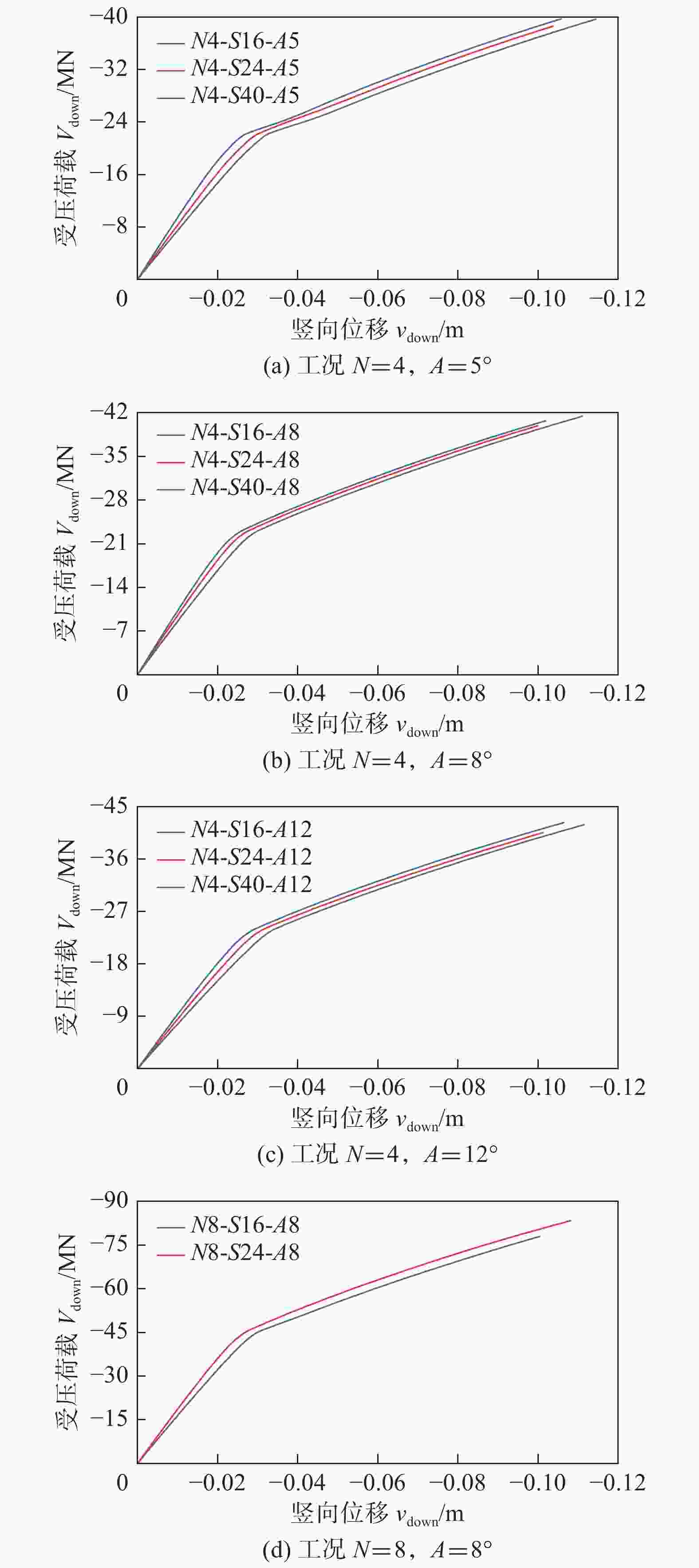
Figure 4. Compressive load - displacement curves of inclined helical pile groups with different pile spacing
如图5(a)所示,各工况下受压效率系数均随间距增加而增大。在倾斜角度为5°时,受压群桩效率系数小于1,表明该倾角下各基桩相互之间为负影响;给定倾角范围内,倾角越大系数越大,当倾角由8°增至12°,其受压承载系数提高了约20%。且A=8°时,N=4与N=8时两曲线几乎重合,系数变化规律相同。如图5(b)所示,抗拔效率系数呈现出与受压效率系数相似的特点,但是系数值更大,表明相较于受压时,抗拔时倾斜群桩基础受桩间距的影响程度更大,倾角为12°时差距更加明显。
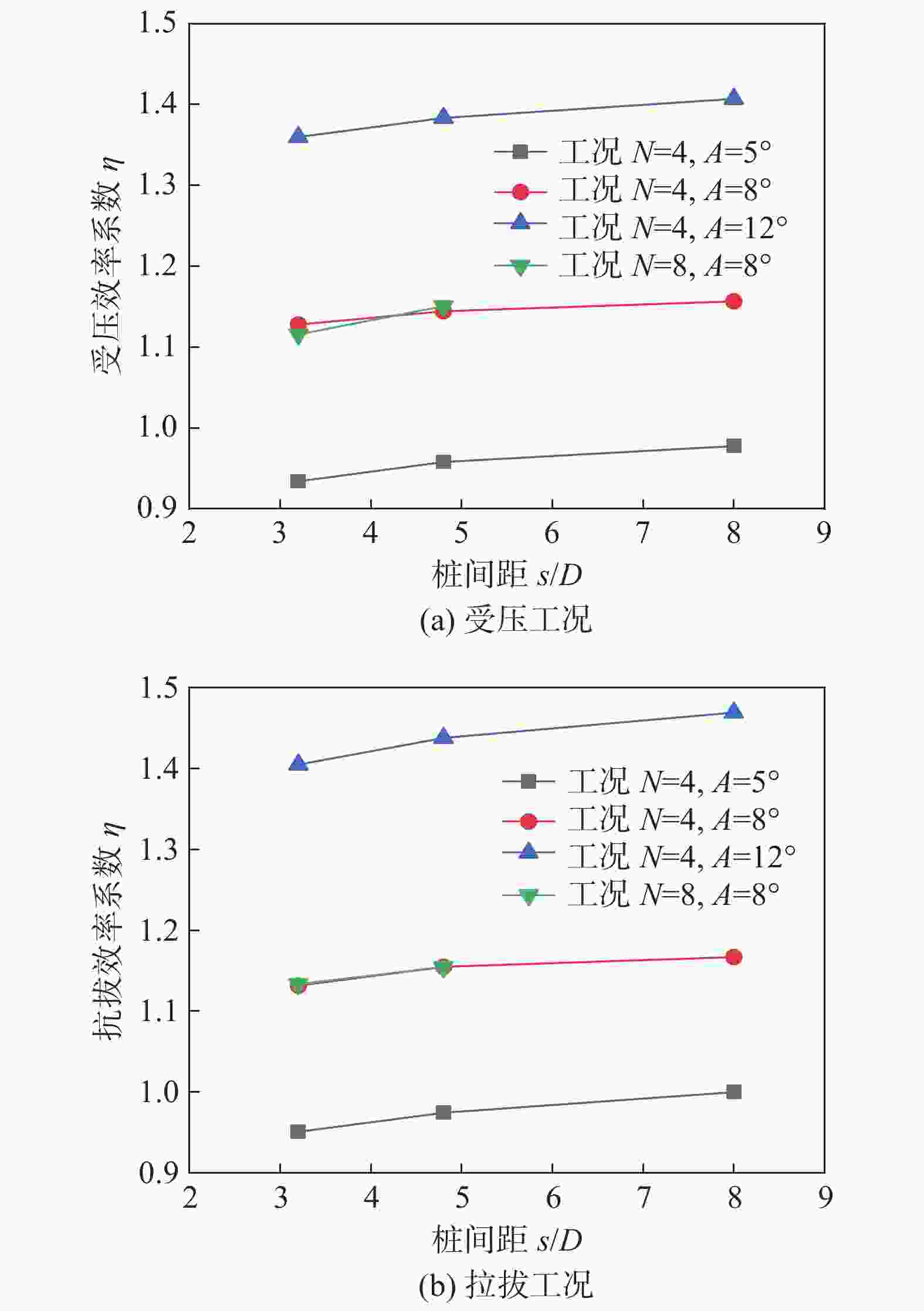
Figure 5. Compression efficiency coefficient variation of pile group with different pile spacing under various working conditions
根据受压极限承载时的位移云图提取群桩中心处不同深度应力值,得到基础中心轴土体竖向位移沿深度变化图(图6)。如图6(a)所示,受压工况下桩间距越小,中心土体压力叠加越显著,中心土体下压位移也越大;可以看到中心土体位移随深度先增大后减小,且间距越小变化规律越明显,位移变化极值均出现在8 m左右深度处。图6(b)为拉拔工况时的位移图,其规律与受压工况类似,但是峰值出现位置随桩间距增大而逐渐上移,且峰值逐渐减小,表5的具体数据也表明了极值深度随间距变化的相同规律。峰值的出现是应力叠加、基桩相互影响的表征现象,两种工况下极值随间距的变化不同,表明受压下桩对土体影响范围更大,桩间相互影响更为稳定。
工况名 极值深度/m 上拔位移/m N4-S16-A5 −14.0 0.0225 N4-S24-A5 −10.0 0.0163 N4-S40-A5 −5.0 0.0084 N4-S16-A8 −12.0 0.0167 N4-S24-A8 −8.0 0.0110 N4-S40-A8 −2.0 0.0046 N4-S16-A12 −11.5 0.2081 N4-S24-A12 −8.0 0.0152 N4-S40-A12 −4.0 0.0077 Table 5. Extreme depth and corresponding uplift displacement under various working conditions
-
如图7所示,当桩数为4时,在5°~8°范围内,倾角越大基础受压性能越好;倾角8°为界点,增加倾角受压承载力提升较小;当桩数为8时,倾角5°~12°,受压承载力随着倾角增大而逐渐增加,未见明显的临界角度。取各工况下0.1 m极限受压承载时的荷载大小,并计算相对于单桩的群桩效率系数如表6所示。
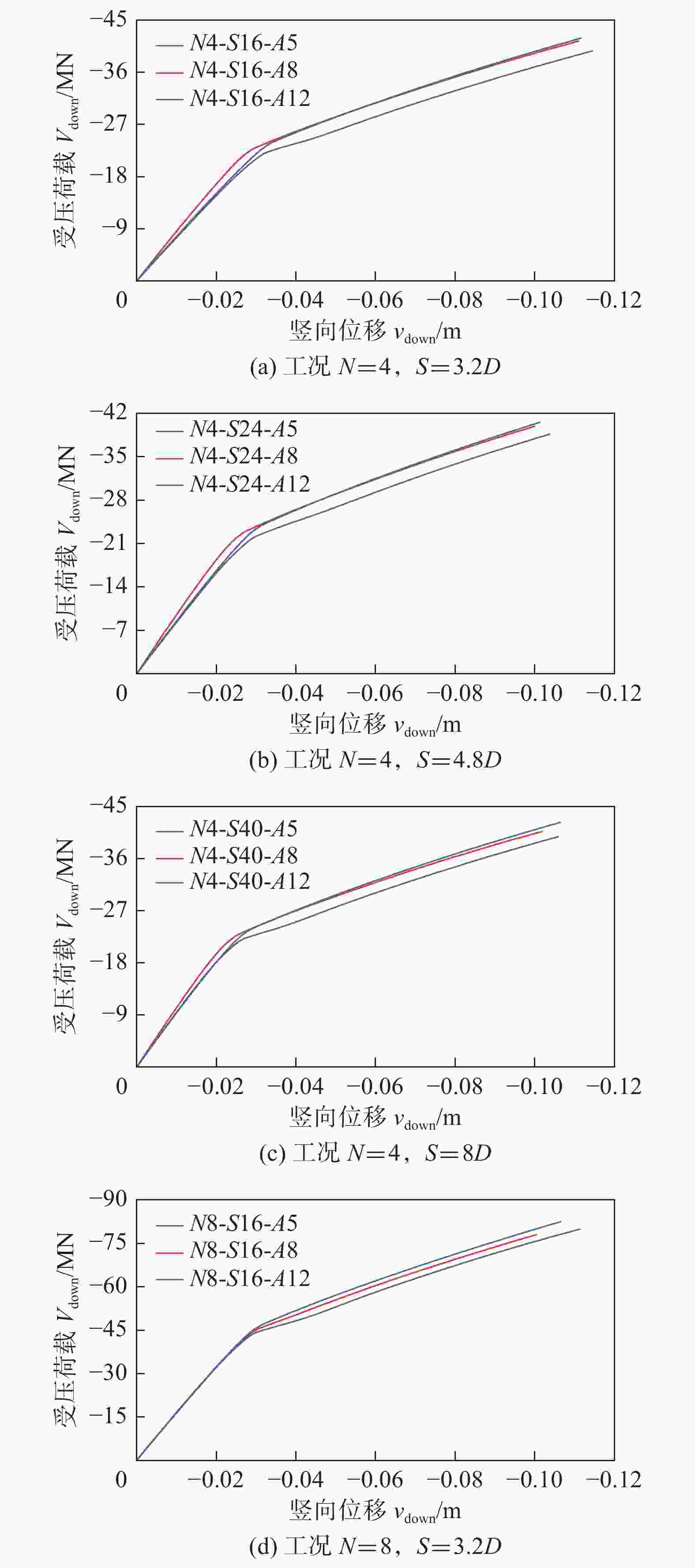
Figure 7. Compressive load - displacement curves of inclined helical pile groups with different inclination angles
工况 受压承载力Qc/MN 群桩效率系数η N4-S16-A5 36.9517 0.9397 N4-S16-A8 39.3328 1.0003 N4-S16-A12 39.6274 1.0077 N4-S24-A5 37.9001 0.9638 N4-S24-A8 39.9018 1.0147 N4-S24-A12 40.3133 1.0252 N4-S40-A5 38.6791 0.9836 N4-S40-A8 40.3285 1.0256 N4-S40-A12 40.9992 1.0426 N8-S16-A5 75.5970 0.9612 N8-S16-A8 77.8069 0.9893 N8-S16-A12 79.7883 1.0145 Table 6. Compressive bearing capacity and pile group efficiency coefficient of helical pile-group foundations with different inclination angles
如表6所示,随着倾角的增大,螺旋桩群桩基础受压承载力逐渐增大,群桩受压效率系数也逐渐增大。其中四桩基础单桩倾角由5°增大到8°,承载力增加4.26%~6.44%,而8°到12°仅增加0.75%~1.66%,且大于8°倾角的受压效率系数都大于1,可见对于受压承载时8°倾角较为高效。
根据受压极限承载时的位移云图提取群桩中心处不同深度应力值,得到基础中心轴土体竖向位移沿深度变化图(图8),图8中各受压位移曲线变化规律一致,位移随深度增加先增大后减小,各工况下中心轴下压位移极值在8 m深度处,该位置处土体应力叠加情况最显著。N=8时,曲线基本重合的原因可能在于相较于N=4而言,桩间距相同,桩数更多,所涉及的土体范围更大,各参数差异所造成的影响对于土体影响很小。在模型所处参数范围内,受压时群桩中心处土体竖向位移极值深度与桩间距、倾角无明显相关关系。
-
倾斜角度对于抗拔承载力的影响如图9所示,各工况下群桩基础承载力随倾角升高而增大,如前文所述,桩数越大增幅越大。抗拔承载力变化规律同受压承载力一致。
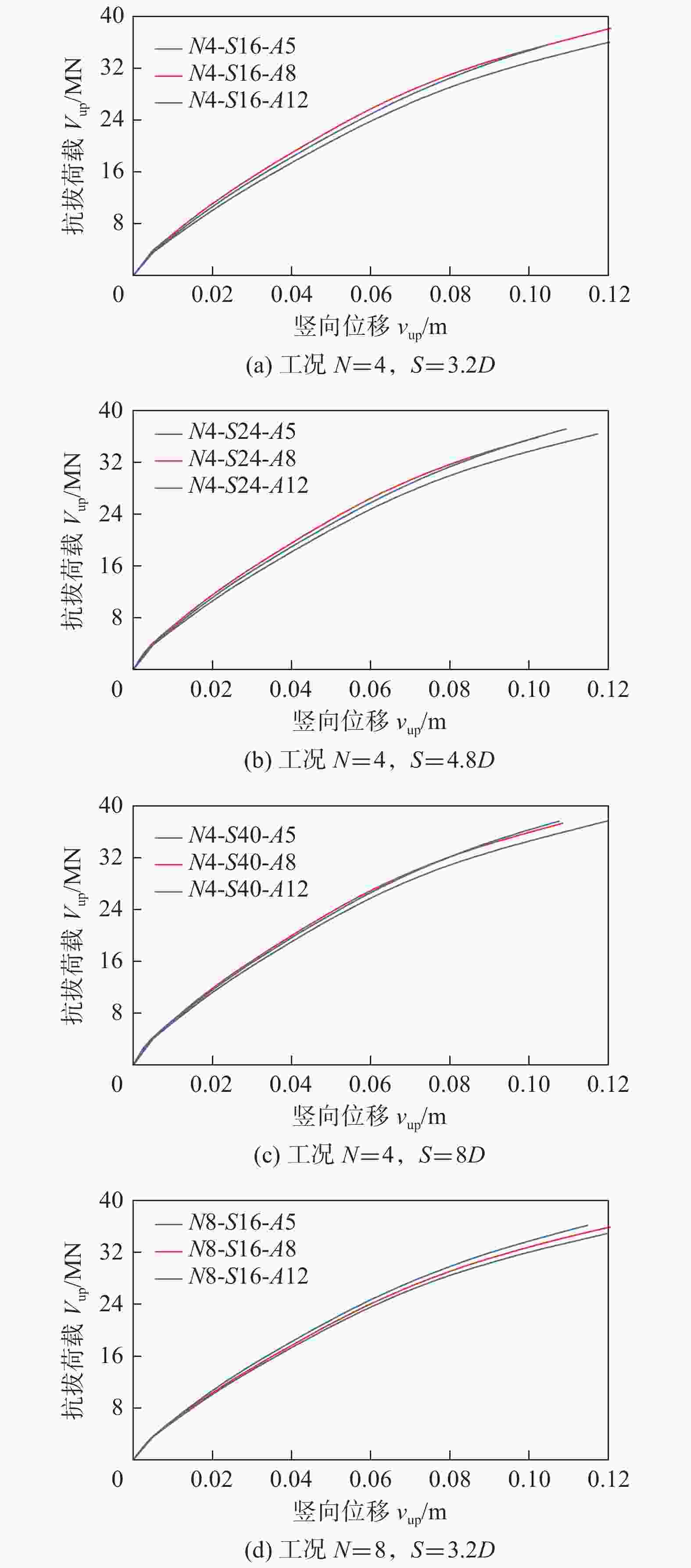
Figure 9. Load - displacement curves of inclined helical pile groups with different inclination angles under uplift conditions
取各工况下0.1 m时的极限拉拔承载力,计算相对于单桩的群桩效率系数(表7)。如表7所示,四桩基础倾角变化由5°增加到8°,抗拔承载力增加了3.82%~5.87%,但是由8°增加到12°,变化只有1.5%;八桩基础各工况间承载力增加值在2.5%左右。且N4-S16工况,从5°到12°群桩效率系数增加了0.0565,N4-S24增加了0.0539,N4-S40增加了0.0505,即涉及土体范围越大,倾斜角度对于承载力的影响越小。
工况 抗拔承载力Qu/MN 群桩效率系数η N4-S16-A5 32.8874 0.9633 N4-S16-A8 34.8180 1.0198 N4-S16-A12 34.7163 1.0169 N4-S24-A5 33.7003 0.9871 N4-S24-A8 35.5292 1.0407 N4-S24-A12 35.5392 1.0410 N4-S40-A5 34.5809 1.0129 N4-S40-A8 35.9018 1.0516 N4-S40-A12 36.3082 1.0635 N8-S16-A5 68.0144 0.9961 N8-S16-A8 69.7417 1.0214 N8-S16-A12 71.7570 1.0509 Table 7. Uplift bearing capacity and pile group efficiency coefficient of helical pile-group foundations with different inclination angles
图10中八桩基础桩间位移等值线在0.0167 m左右开始相互独立,该等值线现状随角度增大逐渐内缩,随着倾斜角度的增大抗拔影响土体范围逐渐扩大;从图11可得四桩基础中心轴位移等值线密度明显小于八桩基础,在0.008 4 m处位移等值线已相互分离;提取中心轴土体位移值沿深度变化如图12所示。
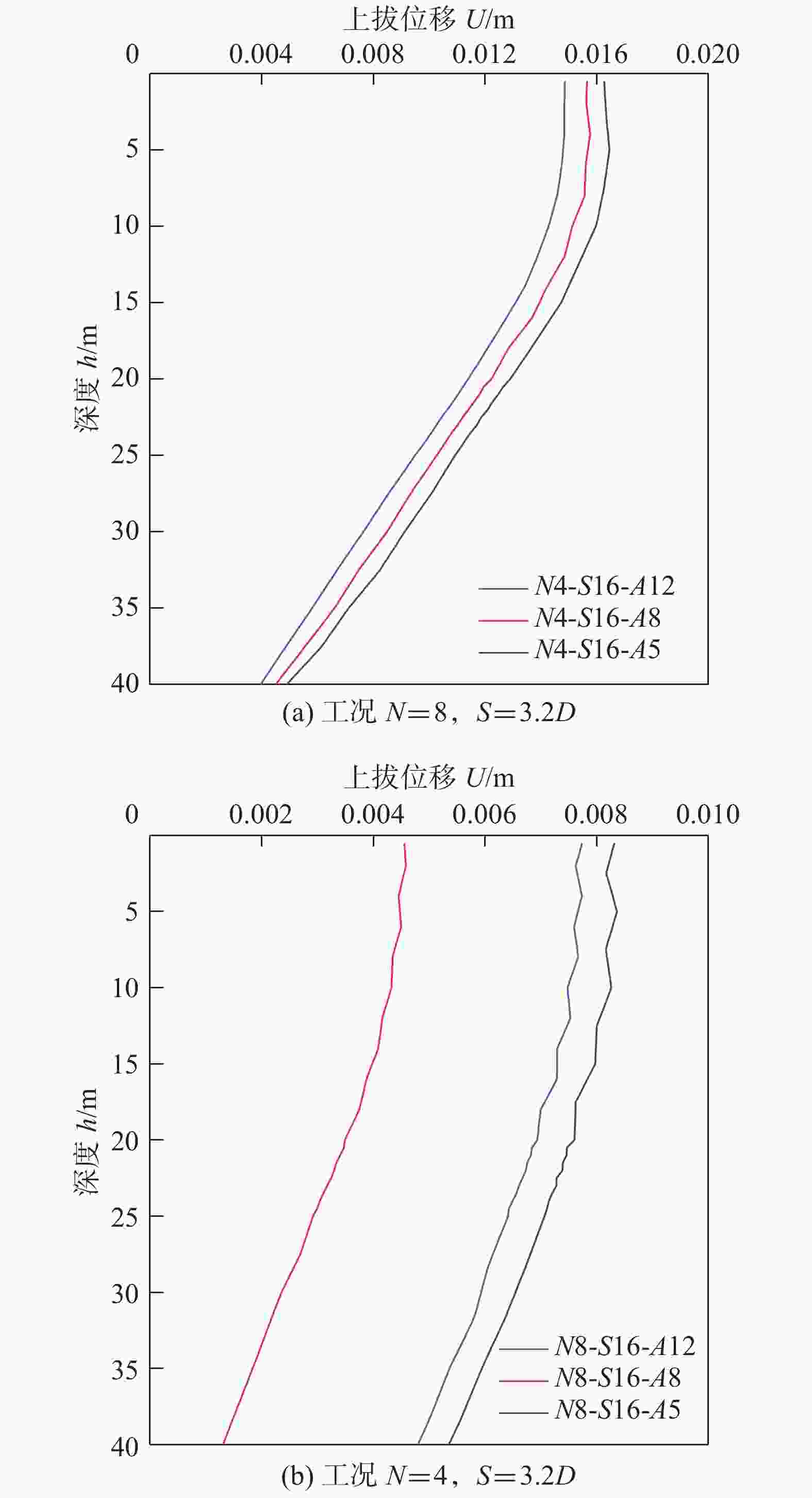
Figure 12. Uplift displacement variation along foundation central axis with depth under different working conditions
图12中表明拉拔时中心轴沿深度方向土体位移先增大后减小,在4~5 m深度处达到最大值,曲线上的数值大小反映了基础中心轴上桩间影响强度的大小,与云图的影响范围是一致的;图12中上拔位移数值与图9中承载力数值是对应关系,承载力越大,上拔位移越小,即抗拔对于土体扰动越小承载力越大;同时也可观察到倾角对于极值点位置无明显的影响。
-
文章通过有限元软件模拟了砂土海床中倾斜螺旋群桩承载特性实验,得到了倾斜螺旋群桩承载力和群桩效应系数随桩数、倾斜角度和桩间距改变的变化规律,具体结论如下:
1)倾斜螺旋群桩效率系数随桩数增多而增大,各基桩彼此形成正影响,群桩效率系数为正,承载力相较于单桩基础有着较为可观的升高,相较于单桩基桩承载力提升了15%左右。
2)倾斜螺旋群桩基础承载力随桩间距呈正相关变化趋势,抗压承载力随桩间距变化幅值为4%左右,抗拔承载力随桩间距变化幅值为3%~5%,倾斜螺旋群桩基础效率系数随桩间距呈正相关变化趋势。相较于桩数和倾角,桩间距对承载力变化幅度影响程度最小。
3)倾角越大,倾斜螺旋群桩基础承载力性能更优异,群桩受压效率系数也随之增大,倾角8°为界点,增加倾角受压承载力提升较小,受压承载时8°倾角较为高效,在0~8°范围内增加倾角对承载力有着较为明显的影响,超过8°增加倾角收效甚微,实际工程中施工方便的情况下,对桩做一定的倾角时可参考此倾角,即实际工程中不推荐使用倾角过大的斜桩。
4)综合来看,倾斜螺旋群桩抗压和抗拔工况的承载力变化规律大致相同。相较于受压工况,受拉拔作用时倾斜螺旋群桩上部土体受到扰动较小,且其受桩间距的影响程度更大,群桩中心处土体竖向位移极值深度随桩间距增大而逐渐上移;倾斜螺旋群桩受压作用时,其对土体影响范围更大,其群桩中心处土体竖向位移极值深度无趋势性变化。
5)文章主要通过数值模拟对单层砂土中安装就位后螺旋桩承载特性进行了相关研究,但是未考虑到螺旋桩安装过程对土体造成的扰动,安装过程中有必要对螺旋桩承载特性的影响进行进一步研究。
Research on Bearing Characteristics of Offshore Inclined Helical Pile-Group Foundations in Sandy Soil
doi: 10.16516/j.ceec.2024.2.08
- Received Date: 2023-05-17
- Rev Recd Date: 2023-06-18
- Available Online: 2024-03-25
- Publish Date: 2024-03-26
-
Key words:
- offshore wind power /
- inclined helical pile /
- finite element analysis /
- pile-group effect /
- bearing characteristics
Abstract:
| Citation: | YANG Weihua, HU Xueyang, ZHANG Puyang, et al. Research on bearing characteristics of offshore inclined helical pile-group foundations in sandy soil [J]. Southern energy construction, 2024, 11(2): 82-92 doi: 10.16516/j.ceec.2024.2.08 |


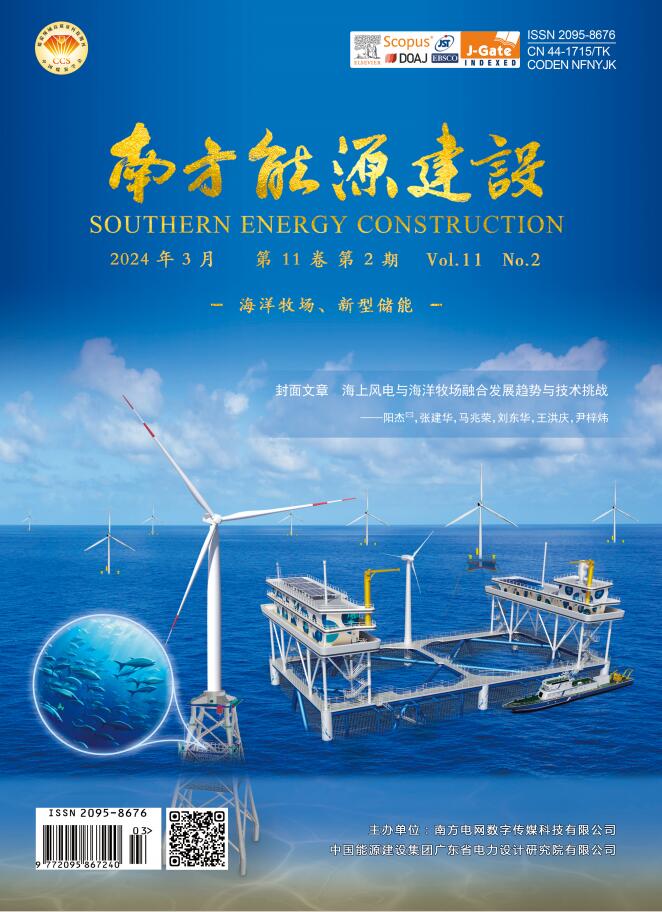

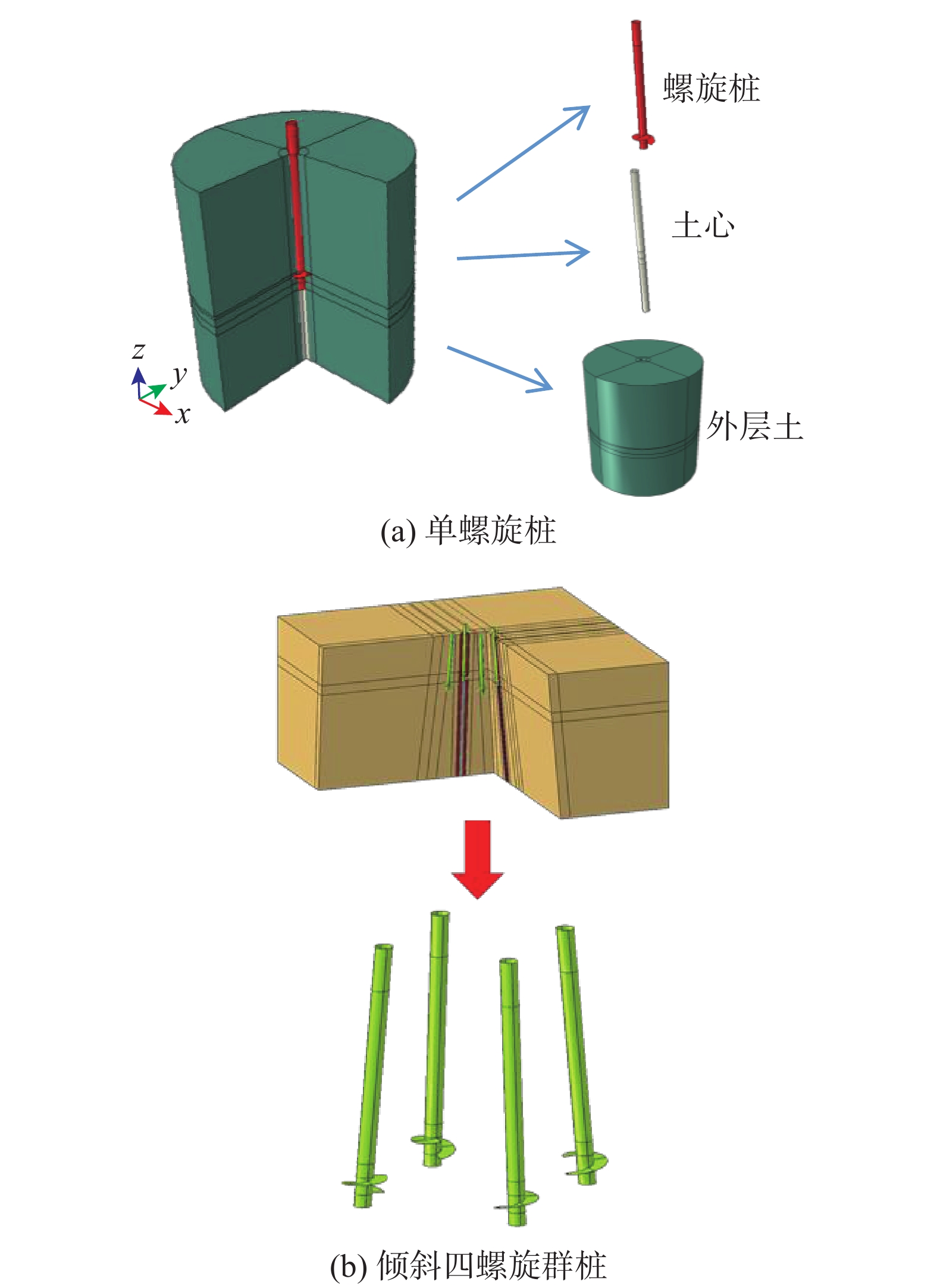

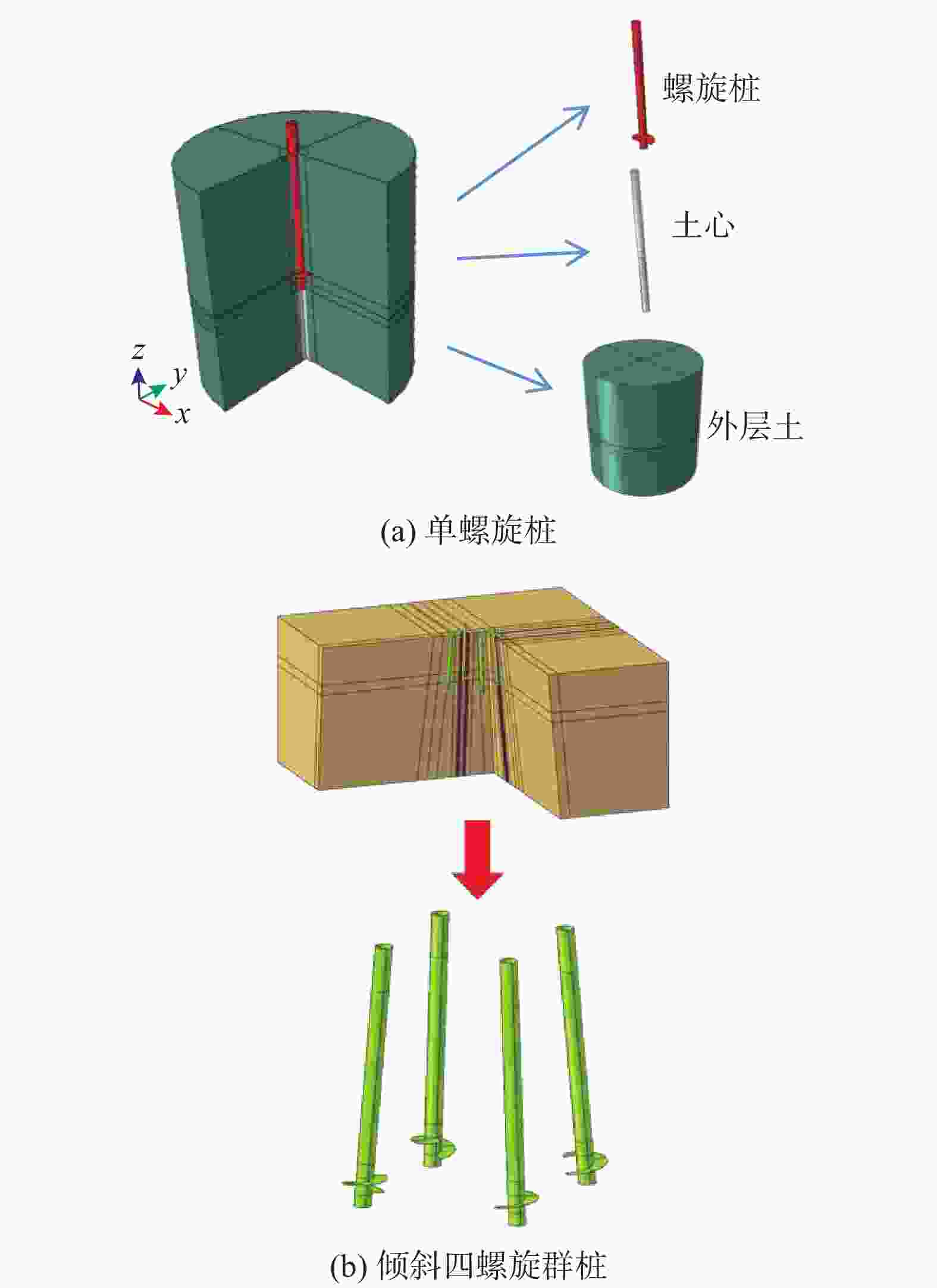
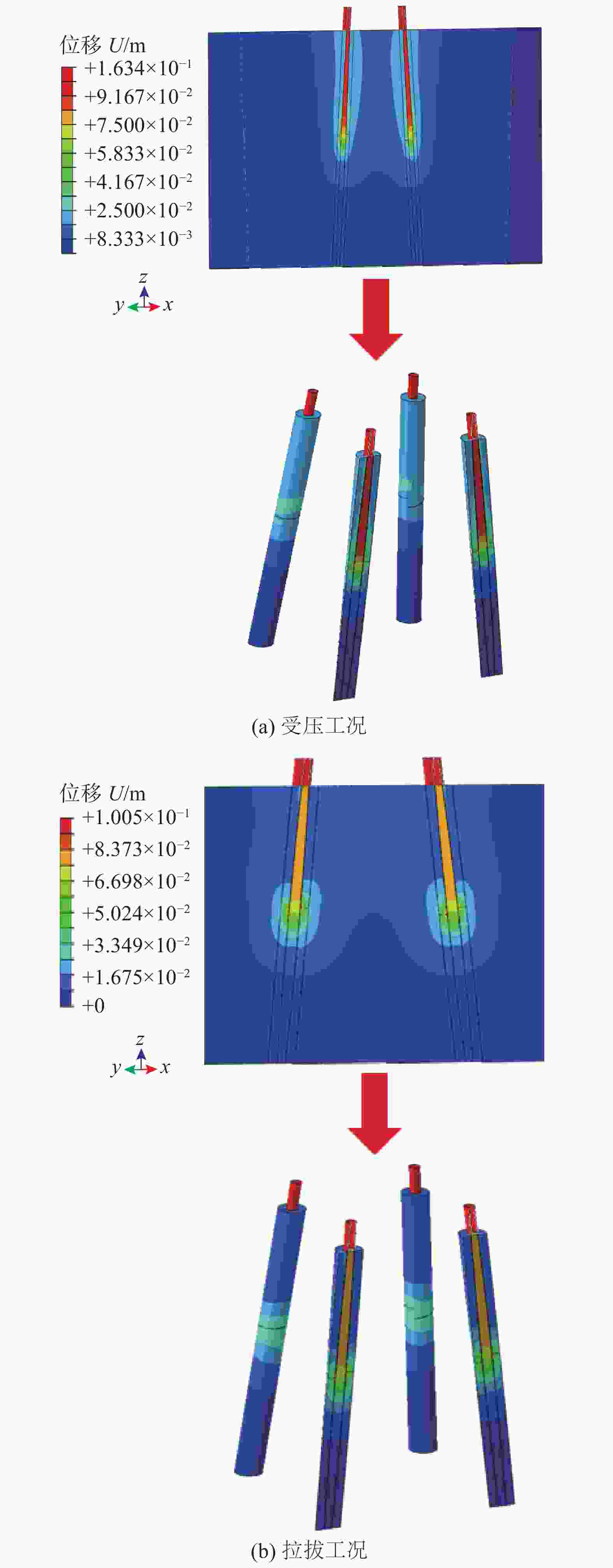
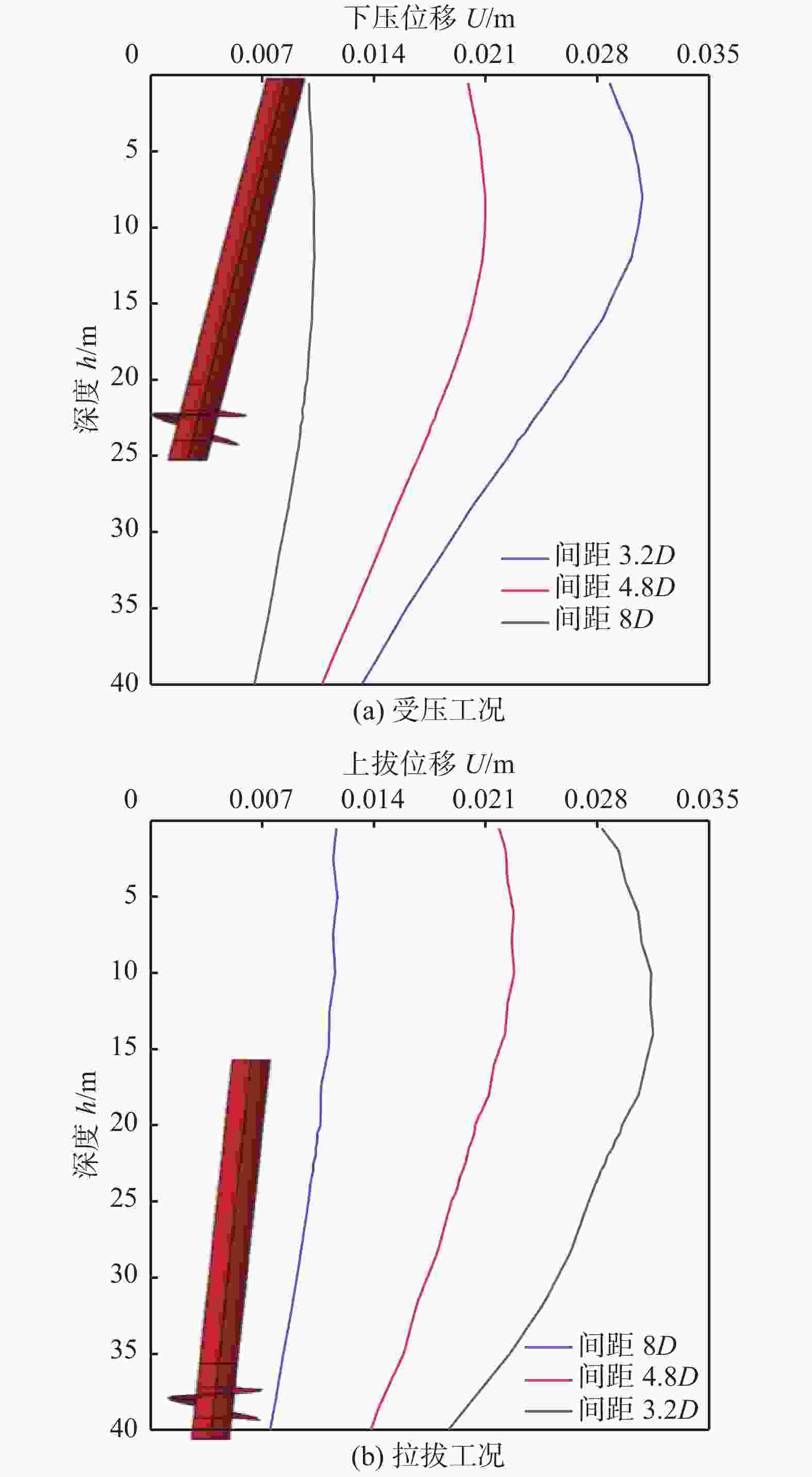
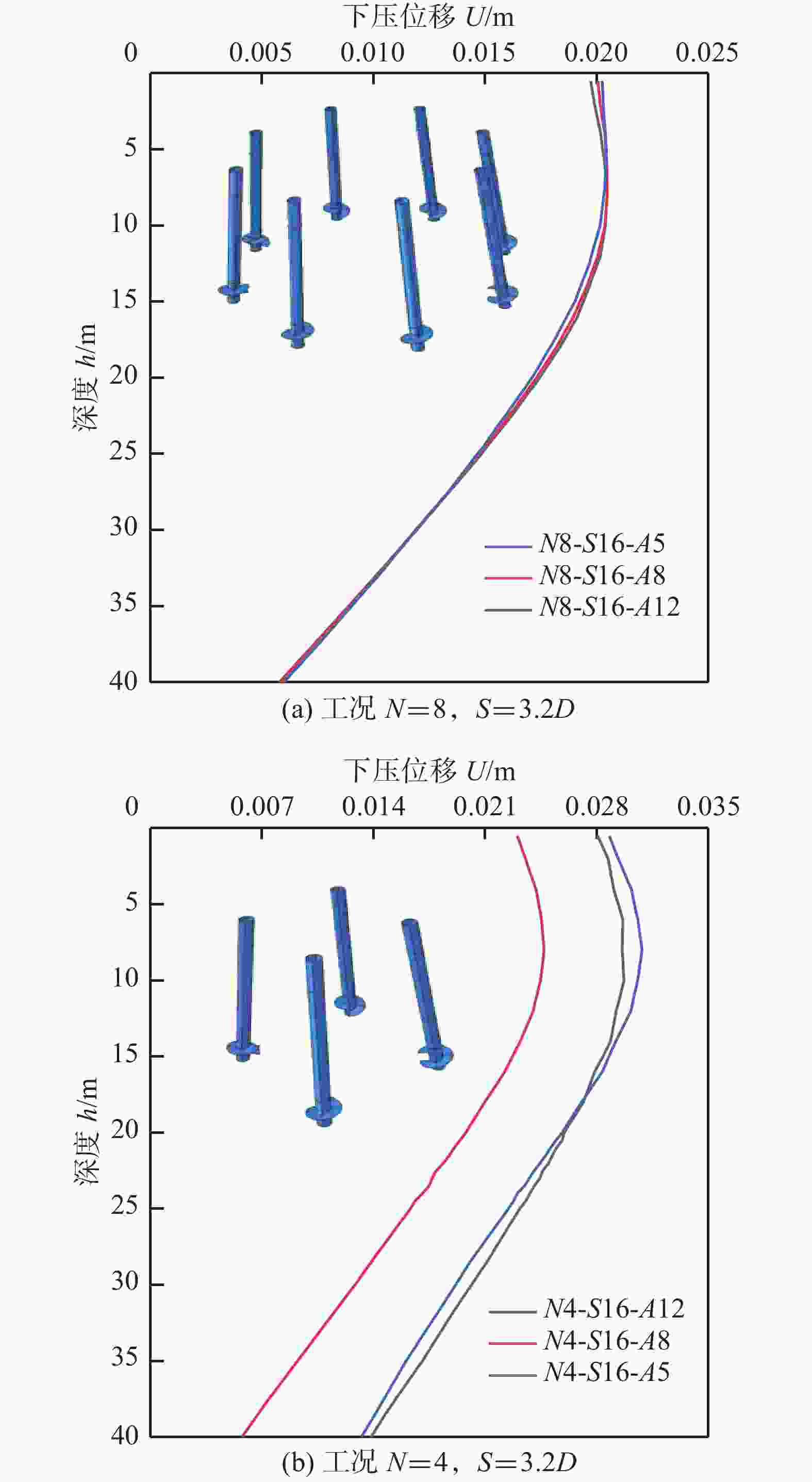
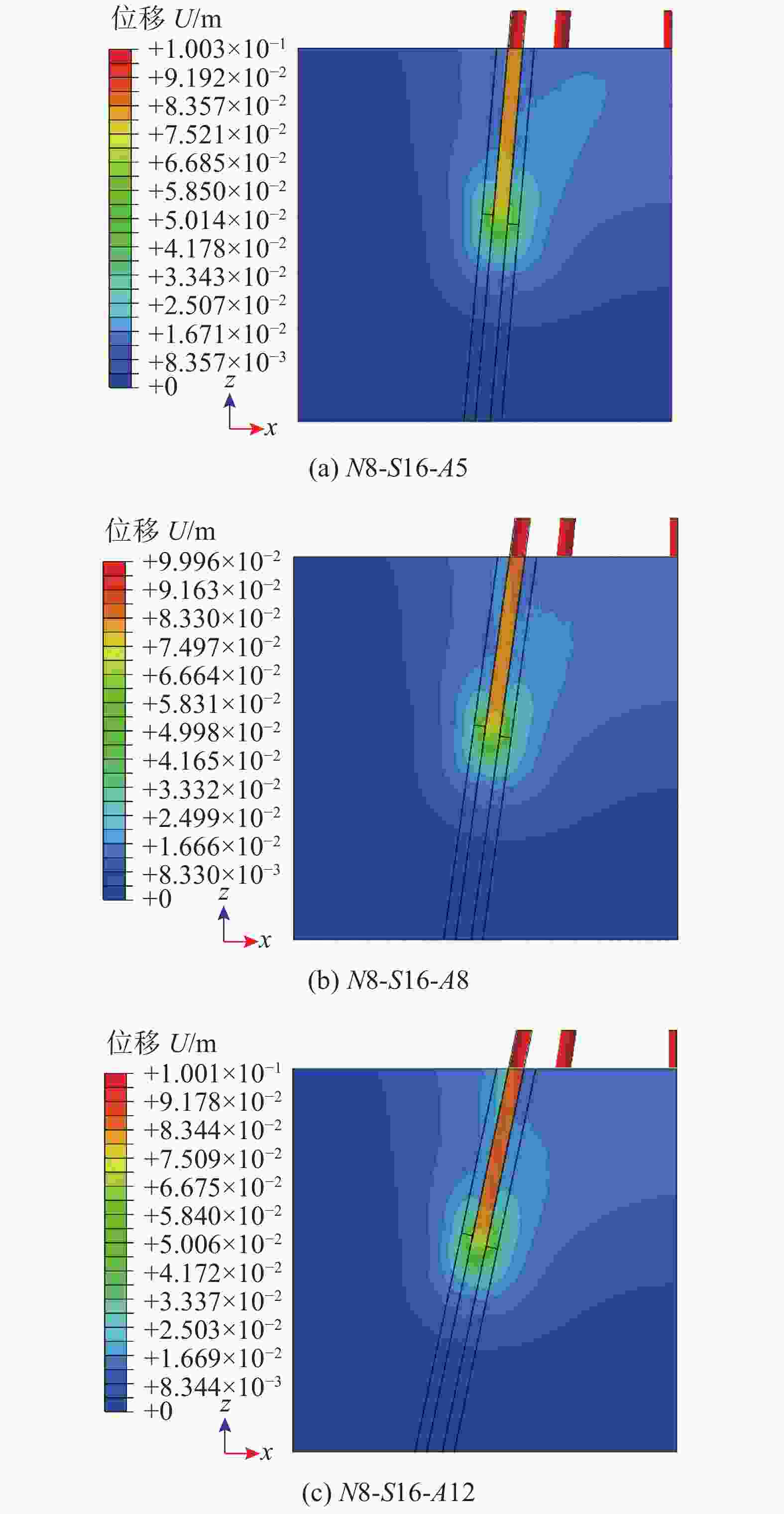
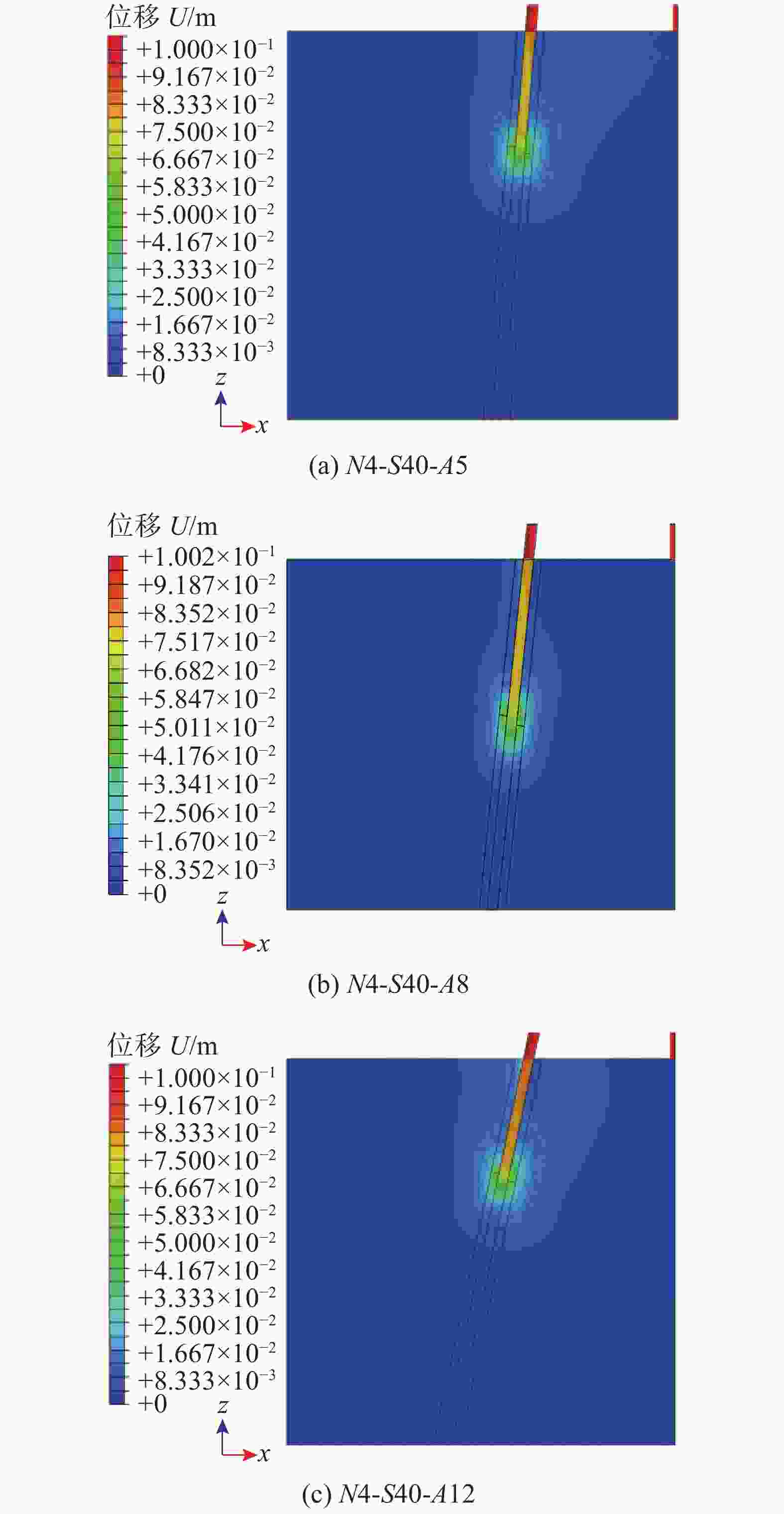

 DownLoad:
DownLoad:
